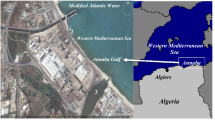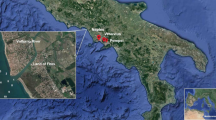Abstract
Sediment cores were collected from five sites in Tokyo Bay. The sediment age was estimated by the210Pb method and the polychlorobiphenyls (PCBs)(2,5,2′,4′,5′ — pentachlorobiphenyl,3,4,2′,4′, 5′-pentachlorobiphenyl, 3,4,2′,3′,4′-pentachlorobiphenyl, 2,3,6,2′,3′,6′-hexachlorobiphenyl, 2,4, 5,2′,4′,5′-hexachlorobiphenyl, and 2,4,5,2′,3′,4′, 5′-heptachlorobiphenyl) profiles in the sediments were determined quantitatively by gas chromatography. With respect to the horizontal distribution of PCBs, the levels were highest off Tokyo and Kawasaki, the inner western part of the bay off the mouths of the Tama and Arakawa Rivers, and declined in the direction of the eastern and southern parts of the bay. It was assumed that most of the PCBs supplied to the bay from the adjacent rivers and the industrial zones along the western coast were coprecipitated with suspended particles near the river mouths and the western coast, while PCBs adsorbed by fine particles are carried throughout the bay by the current. The accumulation rate of PCBs in Tokyo Bay sediments gradually increased, starting about 1936, and reached a maximum value in 1972 and declined moderately thereafter. The time-dependent changes in the quantity released into the environment were estimated from the amount of PCBs manufactured and used. The accumulation rate of PCBs in Tokyo Bay sediments was then compared with the estimated rate of release into the environment.
Similar content being viewed by others
References
Callahan MA, Slimak MW, Gabel NW, May IP, Fowler CF, Freed JR, Jennings P, Durfee RL, Whitmore FC, Maestri B, Mabey WR, Holt BR, Gould C (1979) Water-related environmental fate of 129 priority pollutants. EPA-440/4-79-029b, US Environmental Protection Agency, Washington, DC
Conway RA, Whitmore FC, Hansen WJ (1982) Entry of chemicals into the environment. In: Conway RA (ed) Environmental risk analysis for chemicals. Van Nostrand Reinhold, New York, pp 61–84
Doskey PV, Andren AW (1981) Modeling the flux of atmospheric polychlorinated biphenyls across the air/water interface. Environ Sci Technol 15:705–710
Duke TW, Lower JI, Wilson AJ Jr (1970) Polychlorinated biphenyl (Aroclor 1254) in the water, sediment, and biota of Escambiabay, Florida, Bull Environ Contam Toxicol 5:171–180
Eisenreich SJ, Hollod GJ (1979) Accumulation of polychlorinated biphenyls (PCBs) in surficial lake Superior sediments, atmospheric deposition. Environ Sci Technol 13:569–573
Hattori A (1983) Oceanographie features of Tokyo Bay water circulation, hydrography and nutrient chemistry; an overview. Chikyu Kagaku 17:16–26
Hiraizumi Y, Takahashi M, Nishimura H (1979) Adsorption of polychlorinated biphenyl onto sea sediment, marine plankton, and other adsorbing agents. Environ Sci Technol 13:580–584
Hirao Y, Matsumoto E, Todoroki H, Imamura T, Fukuda E, Kimura K (1983) Record of lead pollution in sediments of the Tokyo Bay, Japan. Geochem J 17:19–27
Jensen S, Sundström G (1974) Structures and levels of most chlorobiphenyls in two technical PCB products and in human adipose tissue. Ambio 3:70–76
Jonas RB, Pfaender FK (1976) Chlorinated hydrocarbon pesticides in western north Atlantic ocean. Environ Sci Technol 10:770–773
Karickhoff SW, Brown DS, Scott TA (1979) Sorption of hydrophobic pollutants on natural sediments. Water Res 13:241–248
Lerman A, Lietzke TA (1975) Uptake and migration of traces in lake sediments. Limnol Oceanogr 20:497–510
Lindstrom FT, Boersmal L, Gardiner H (1968) 2,4-D diffusion in saturated soils: A mathematical theory. Soil Sci 106:107–113
Lotse EG, Graetz PA, Chesters G, Lee GB, Newland LW (1968) Lindane adsorption by lake sediments. Environ Sci Technol 2:353–357
Mackay D, Leinenen PJ (1975) Rate of evaporation of low solubility contaminants from water bodies to atmosphere. Environ Sci Technol 9:1178–1180
Matsumoto E, Yokota S (1977) Records of pollution in Tokyo bay sediments. Chikyu Kagaku 11:51–57
Matsumoto E (1983) The sedimentary environment in the Tokyo bay. Chikyu Kagaku 17:27–32
Pionke HB, Chesters G (1973) Pesticide-sediment-water interactions. J Environ Qual 2:29–45
Sayler GS, Colwell RR (1976) Partitioning of mercury and polychlorinated biphenyl by oil, water, and suspended sediment. Environ Sci Technol 10:1142–1145
Steen WC, Paris DF, Baughman GL (1978) Partitioning of selected polychlorinated biphenyls to natural sediments. Water Res 12:655–657
Tastukawa R, Tanabe S (1980a) Production and physicochemical properties of PCBs. In: the Japan Chem. Soc. (ed) PCB. Maruzen, Tokyo, pp 6–9
— (1980b) Environmental behavior of PCBs. In: the Japan Chem. Soc. (ed) PCB. Maruzen, Tokyo, pp 10–20
Unoki S, Kishino M (1977) Oceanography conditions and water exchange in Tokyo Bay. Technical report of physical oceanography laboratory, Institute of Physical and Chemical Research, Japan, pp 89
Wakimoto T, Tatsukawa R, Ogawa T (1971) An analytical method for PCB. J Environ Pollut Control 7:517–522
Author information
Authors and Affiliations
Rights and permissions
About this article
Cite this article
Sugiura, K., Kitamura, M., Matsumoto, E. et al. Polychlorobiphenyis (PCBs) in sediments of Tokyo Bay, Japan. Arch. Environ. Contam. Toxicol. 15, 69–76 (1986). https://doi.org/10.1007/BF01055250
Received:
Revised:
Issue Date:
DOI: https://doi.org/10.1007/BF01055250




